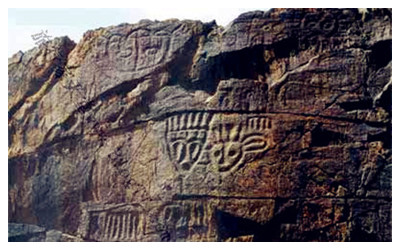- Home
- Province Guide > Inner Mongol >
Yinshan Mountain Rock Paintings

Yinshan Rock Paintings of are scattered over a wide area of Yinshan Mountainous in Inner
Mongolia Autonomous Region. More than 1,000 rock paintings can be found in this area.
The earliest record of the rock paintings of Yinshan Mountain in the world is the renowned "Work-Commentary on the Waterways Classic" by Li Daoyuan, a geologist of the Northern Wei Dynasty (AD 386-534). A comprehensive survey of the rock paintings started in 1976. Since then, more than 10,000 rock paintings have been discovered, and nearly 1,000 of them have been photographed or copied.
These rock paintings not only reflect the beliefs, aesthetic standards and world outlook of the ancient in habitations in Yinshan Mountain areas, but also present a truthful picture of their nomadic life.
The themes of the rock paintings are in general the hunting activities of the nomadic ethnic groups. Among the rock paintings, the most numerous and most finely drawn ones are pictures of animals, including goats, sheep, argali, antelopes, blue sheep, elks, white-lipped deer, cervus elaphus, David's deer, moose (also known as han da an), roe deer, horses, mules, donkeys, camels, oxen, wild oxen, takins, dogs, turtles, wild boars, rabbits, foxes, snakes, wolves, tigers and leopards. Scenes of hunting represent the social life of the prehistoric nationalities. Scenes of hunters, weapons and hunting techniques are depicted in the paintings.
Certain rules were followed in the themes and distributions of the rock paintings of Yinshan Mountain: drawings of wild animals are found mostly on rocks on mountaintops, scenes of hunting generally half way up the mountains, while head portraits of gods, celestial bodies and constellations are mostly engraved on steep cliffs in the valleys or on giant rocks on hillsides by valleys (primitive people believed that gods lived in places of swift currents). These rules are in conformity to the social environment in which the paintings were drawn and the ideologies held by people then.
The rock paintings of Yinshan Mountain can be divided into groups of four ages and five periods:
Paintings of the first age are the works of primitive clan tribes of the period from the late Paleolithic Age to the mid Bronze Age. Rock paintings in this period were in a period of prosperity with their large numbers, wide distributions and delicate craftsmanship.
The rock paintings of the second age are those drawn by the Huns during the period from the Spring and Autumn Period (770-476 BC) to the Western and Eastern Han dynasties (206 BC-AD 220).
The third age mainly refers to the rock paintings of the Turk style, equivalently from the Northern Dynasty (386-581) to the Tang Dynasty (618-907).
Rock paintings of the fourth age are mainly works of the
Mongolians after the
Yuan Dynasty (1271-1368). The colored rock paintings are unique to the Mongolians. Apart from some themes of the life and production activities (for example, galloping horses, two-humped camels, herdsman, etc.), most of the paintings are designs related to Lamaism.
The rock paintings of Yinshan Mountain were drawn mostly by either chiseling or grinding. They are plain and vivid in their artistic features and are mostly based on realistic depictions and presenting a record of the social life of the early historical stages of human beings.
Travel Tips
Add: Yinshan Mountainous in Inner Mongolia Autonomous Region
Opening Hours: 08:00-18:00
Entrance Fees: CNY 80
 Yinshan Rock Paintings of are scattered over a wide area of Yinshan Mountainous in Inner Mongolia Autonomous Region. More than 1,000 rock paintings can be found in this area.
Yinshan Rock Paintings of are scattered over a wide area of Yinshan Mountainous in Inner Mongolia Autonomous Region. More than 1,000 rock paintings can be found in this area. Ask Questions ?
Ask Questions ?